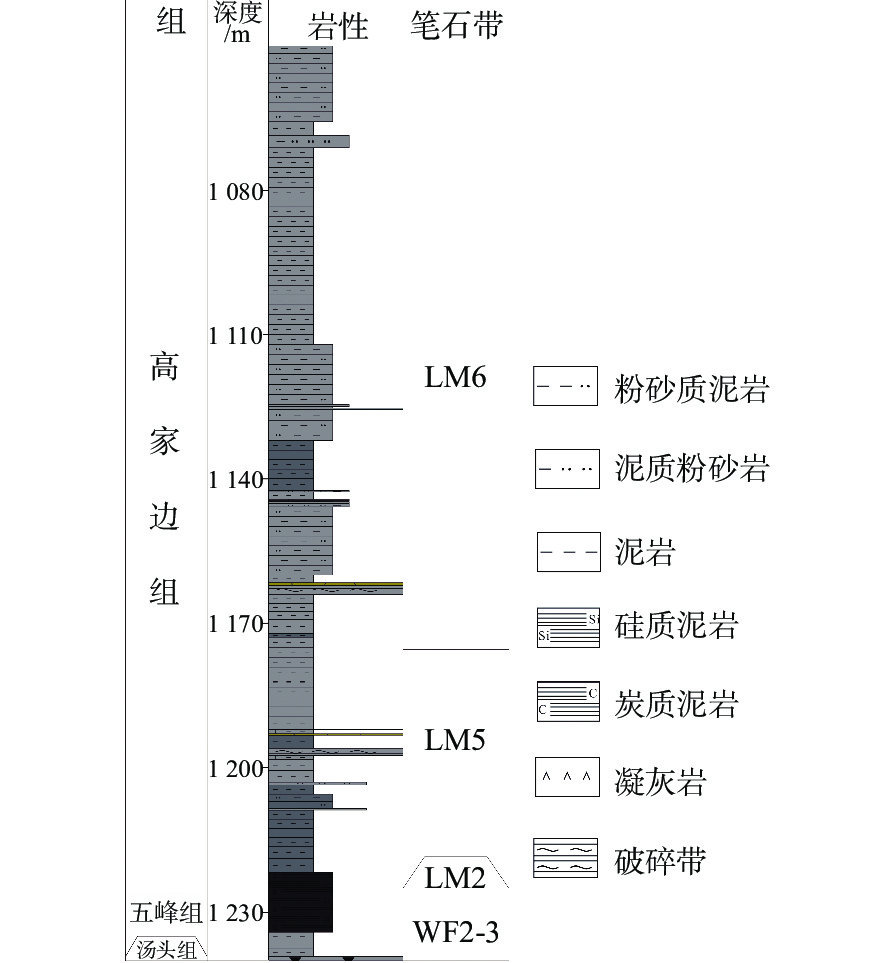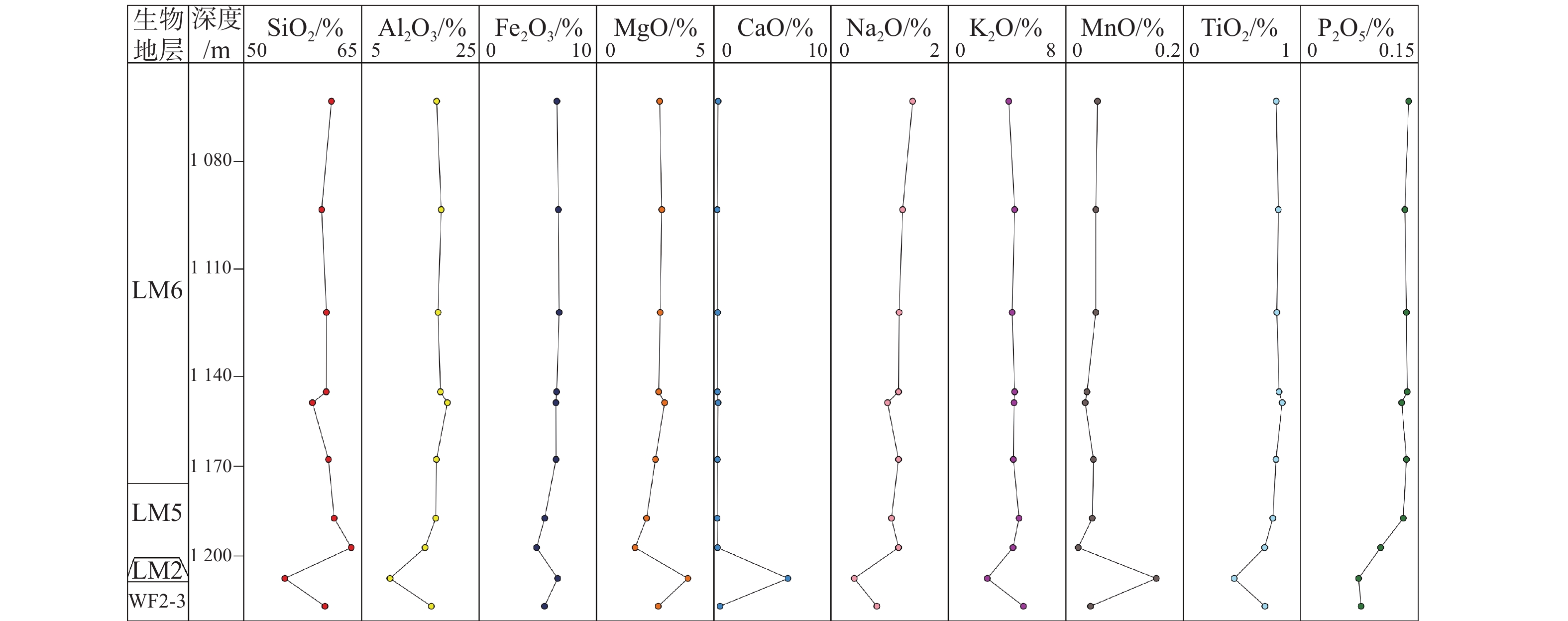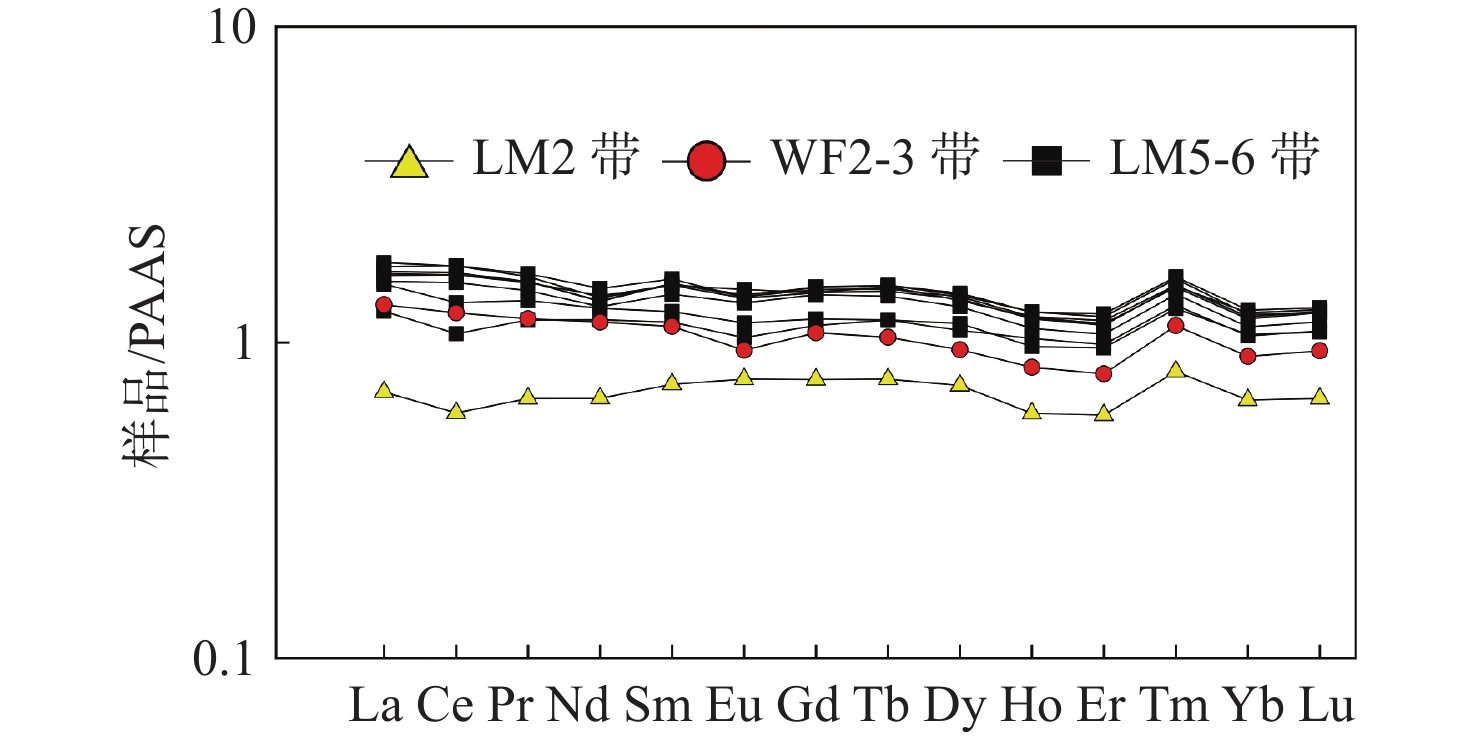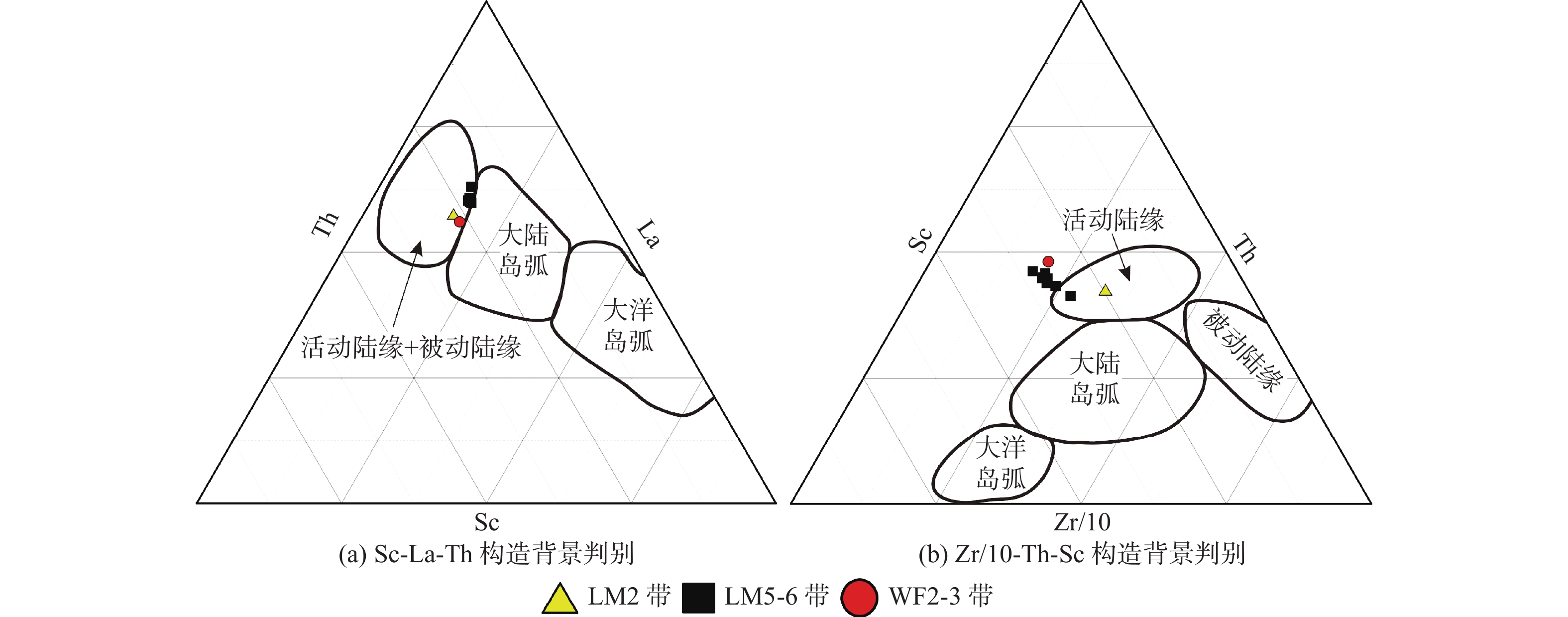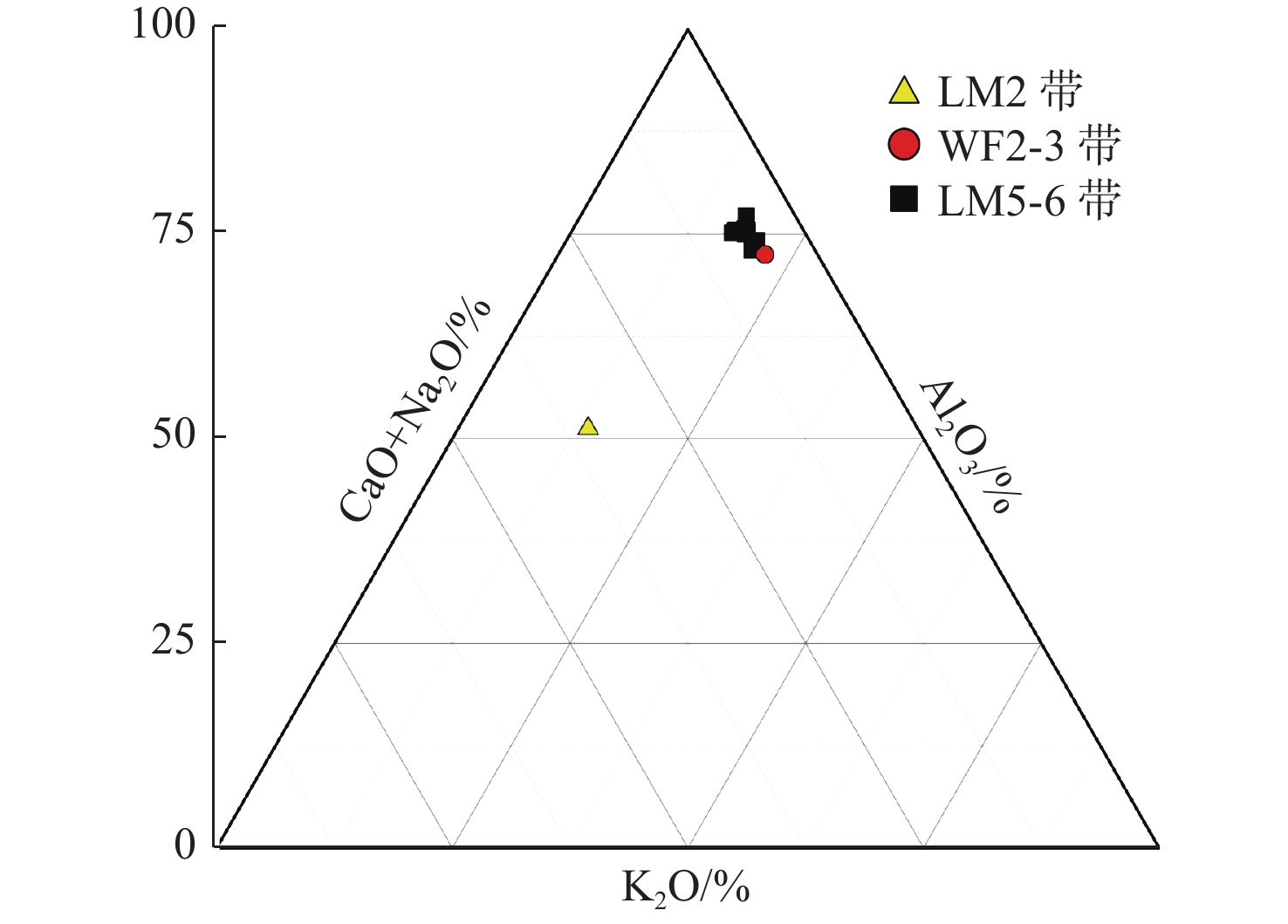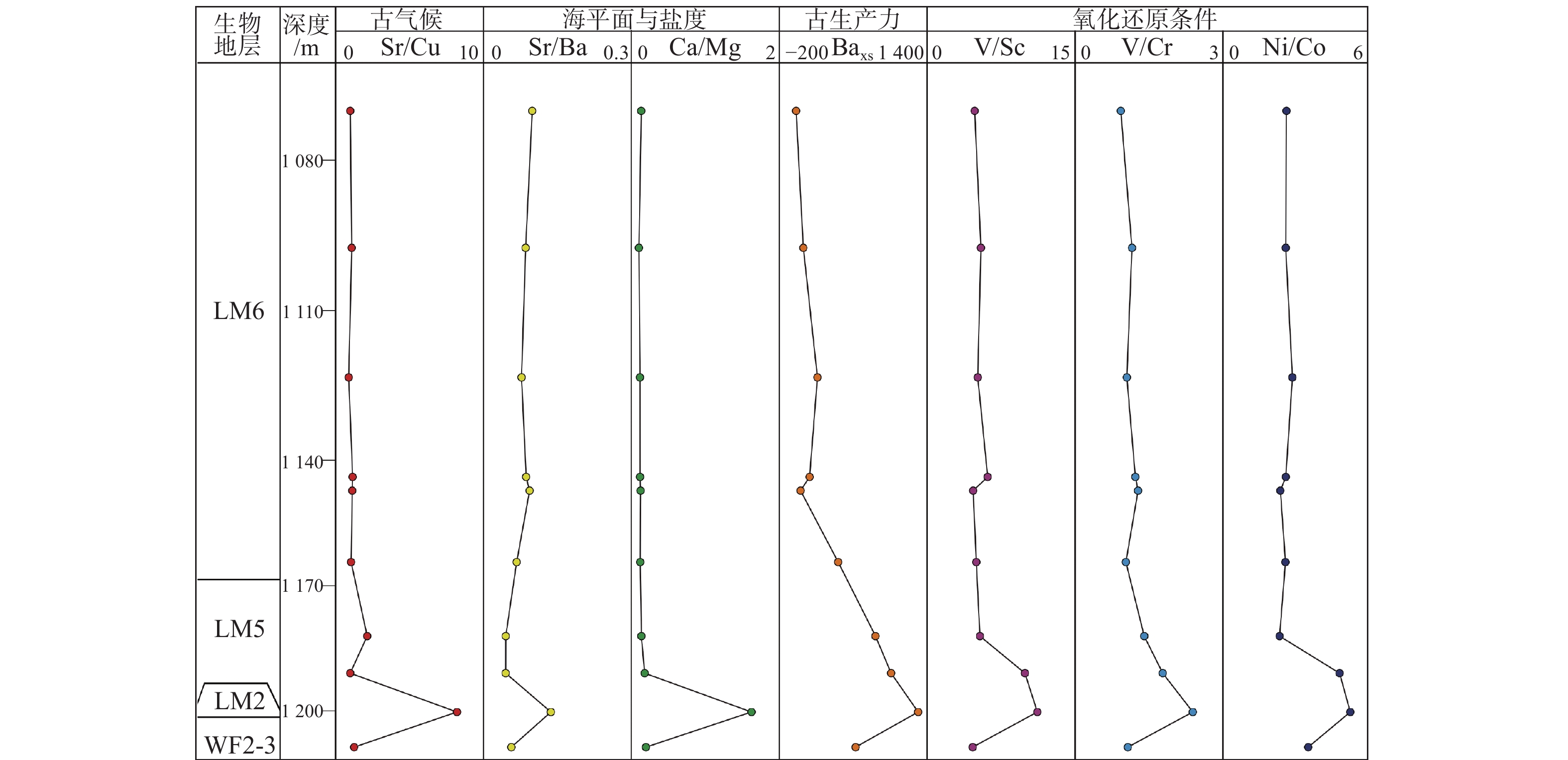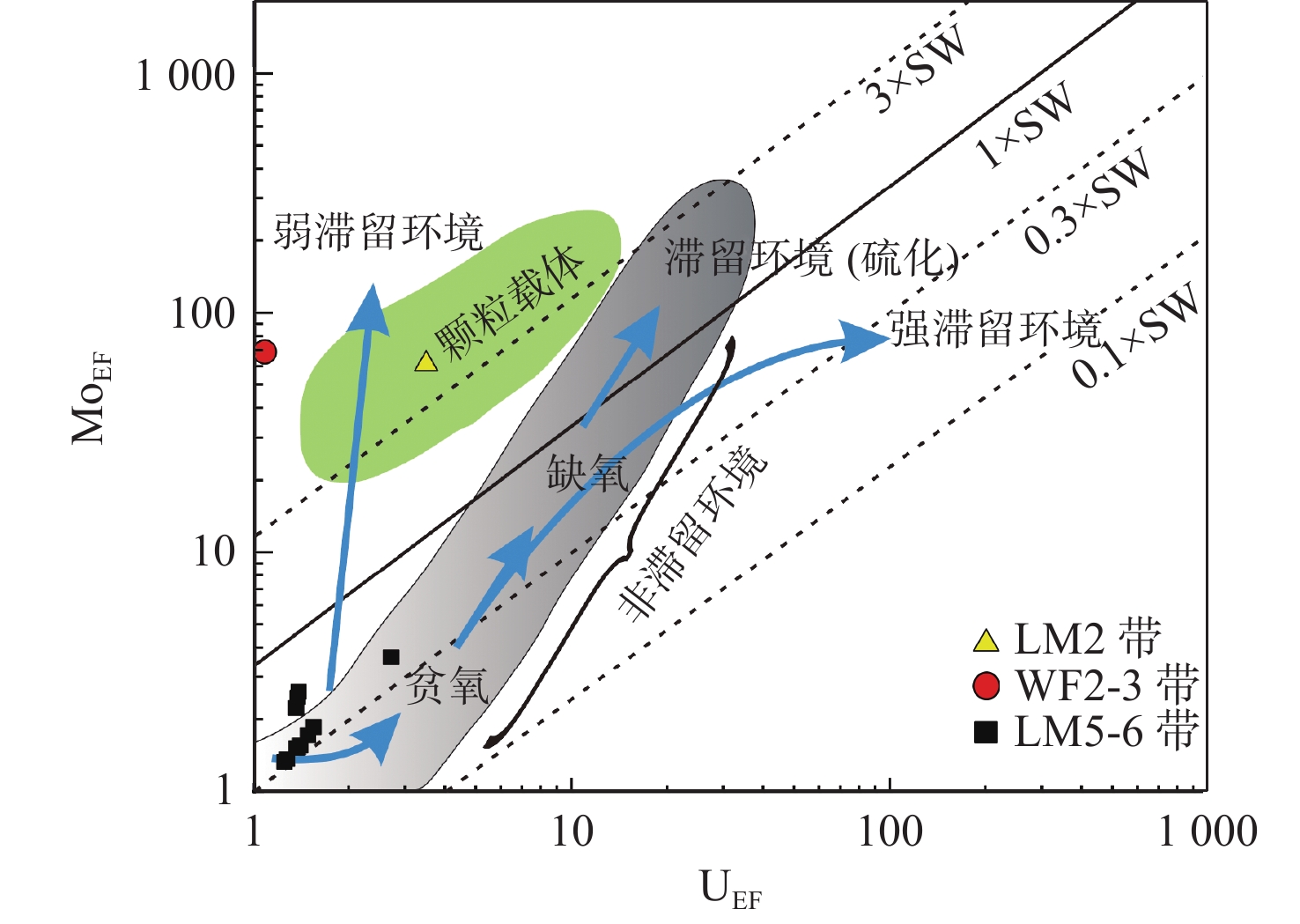Geochemical characteristics and geological significance of shale in the lower member of Wufeng-Gaojiabian Formation of Well Gudi 1 in Chaohu area, Lower Yangtze region
-
摘要:
下扬子巢湖地区鼓地1井揭示了上奥陶统五峰组(WF2-3带)和下志留统高家边组下段(LM2带和LM5-6带)页岩。基于该套地层的页岩岩心样品的元素地球化学测试分析,对其沉积构造背景、物源区背景、古气候、古生产力、海水深度和盐度、氧化还原条件进行了研究。结果表明,鼓地1井五峰组-高家边组下段页岩主量元素、微量元素以及稀土元素纵向分布不均匀,LM2带与WF2-3带和LM5-6带相比明显异常。沉积时期的构造环境主要为活动大陆边缘,同时兼具大陆岛弧的特征。物源具有长英质物源和成熟大陆石英物源混合物源的特征。WF2-3带和LM5-6带为浅水环境,底层海水含氧高,气候温暖湿润,古生产力较低,海水较浅且盐度较低;LM2带为深水环境,海水盐度高、滞留程度较弱,底层海水缺氧,气候干燥炎热,古生物生产力较强。
Abstract:Well Gudi 1 reveals the strata of the WF2-3 member of Wufeng Formation (Upper Ordovician) and the LM2 and LM5-6 members of lower member of Gaojiabian Formation (Lower Silurian). The element geochemistry characteristics of shale samples from the studied strata has been analyzed, and its sedimentary tectonic background, provenance background, paleoclimate, paleoproductivity, seawater depth and salinity, redox conditions are thus studied subsequently. The results show that the vertical distribution of major elements, trace elements and rare earth elements in the shale of the lower member of Wufeng Formation-Gaojiabian Formation of well Gudi 1 is uneven, and the LM2 member is obviously abnormal compared with WF2-3 member and LM5-6 member. The tectonic environment during the sedimentary period is mainly the active continental margin environment, which also has the characteristics of continental island arc. The provenance is characterized by a mixture of felsic provenance and mature continental quartz provenance. WF2-3 and LM5-6 are in shallow water environment, with high oxygen content in bottom seawater, warm and humid climate, low paleoproductivity, shallow seawater and low salinity; LM2 member is a deep-water environment with high seawater salinity and weak retention. The bottom seawater is anoxic, dry and hot climate and strong paleontological productivity.
-

-
图 2 鼓地1井五峰组-高家边组下段地层特征[5]
Figure 2.
图 6 鼓地1井五峰组-高家边组下段页岩沉积构造背景判别[24]
Figure 6.
图 7 鼓地1井五峰组-高家边组下段页岩物源区背景判别[23]
Figure 7.
图 8 鼓地1井五峰组-高家边组下段页岩A-CN-K图解[30]
Figure 8.
表 1 鼓地1井五峰组-高家边组下段与下扬子区地层对比[5]
Table 1. Stratigraphic correlation between the lower member of Wufeng-Gaojiabian Formation and Lower Yangtze region of Well Gudi 1[5]
下扬子地层 鼓地1井 阶 笔石带 井深/m 埃隆阶 LM8 / LM7 / LM6 1 175.5 鲁丹阶 LM5 1 224.5 LM4 缺失 LM3 LM3 1 226.2 赫南特阶 LM1 缺失 WF4 凯迪阶 WF3 1 237.8 WF2 WF1 缺失 表 2 鼓地1井五峰组-高家边组下段主量元素测试结果
Table 2. Test results of major elements in the lower member of Wufeng-Gaojiabian Formationof Well Gudi 1
样品编号 深度/m 主量元素含量/% SiO2 Al2O3 Fe2O3 MgO CaO Na2O K2O MnO TiO2 P2O5 GD-1 1 063 61.15 17.79 6.62 2.69 0.36 1.39 4.11 0.05 0.791 0.138 GD-2 1 100 59.9 18.56 6.75 2.78 0.28 1.22 4.51 0.05 0.809 0.133 GD-3 1 135 60.51 18.02 6.82 2.71 0.31 1.16 4.34 0.05 0.796 0.135 GD-4 1 162 60.48 18.42 6.6 2.65 0.31 1.15 4.51 0.04 0.815 0.136 GD-5 1 165.7 58.72 19.62 6.54 2.9 0.36 0.963 4.47 0.03 0.842 0.129 GD-6 1 185 60.76 17.75 6.55 2.51 0.30 1.15 4.42 0.05 0.789 0.135 GD-7 1 205 61.5 17.63 5.59 2.13 0.29 1.03 4.81 0.05 0.762 0.131 GD-8 1 215 63.67 15.81 4.9 1.64 0.29 1.15 4.4 0.02 0.692 0.102 GD-9 1 225.5 55.19 9.84 6.69 3.89 6.32 0.396 2.65 0.15 0.433 0.074 GD-10 1 235 60.32 16.88 5.57 2.63 0.52 0.781 5.11 0.04 0.695 0.077 表 3 鼓地1井五峰组-高家边组下段微量元素测试结果
Table 3. Test results of trace elements in the lower member of Wufeng-Gaojiabian Formationof Well Gudi 1
样品编号 深度/m 微量元素含量/(μg/g) Sc V Cr Co Ni Cu Mo Sr Ba Th U Zr Hf GD-1 1 063 17.3 83.4 89.8 17.2 44.4 71.5 0.302 69.9 708 22.6 3.96 114 3.71 GD-2 1 100 18.1 98.8 85.4 17 43.4 64.7 0.301 69.8 818 23.9 4.15 111 3.72 GD-3 1 135 17.4 89.4 85 18 50.8 83.5 0.339 73.2 949 23.3 4.13 129 4.06 GD-4 1 162 17.1 105 85.7 18 46 66.7 0.518 76 880 22.9 4.47 107 3.36 GD-5 1 165.7 18.7 87.3 68.2 21.1 49.3 69.5 0.353 77.6 831 24.8 4.42 99.8 3.27 GD-6 1 185 17.3 86.3 83.6 16.8 42.7 75.1 0.492 78 1162 24.1 4.48 110 3.57 GD-7 1 205 16 85.7 61 16.8 38.7 33 0.617 70.2 1561 21.7 4 106 3.44 GD-8 1 215 13.6 135 75.8 16.8 79.6 75.6 6.51 74.2 1656 18.3 7.02 122 3.96 GD-9 1 225.5 7.27 81.3 34 5.76 29.8 28.4 12.4 233 1705 12.6 5.69 98.9 2.9 GD-10 1 235 15.5 71.6 66.8 11.4 39.5 59.5 0.626 74.1 1315 23.9 2.89 101 3.88 表 4 鼓地1井五峰组-高家边组下段稀土元素测试结果
Table 4. Test results of rare earth elements in the lower member of Wufeng-Gaojiabian Formationof Well Gudi 1
样品
编号深度/m 稀土元素含量/(μg/g) La Ce Pr Nd Sm Eu Gd Tb Dy Ho Er Tm Yb Lu GD-1 1 063 59.4 124 13 41.6 7.97 1.47 6.66 1.08 5.72 1.11 3.08 0.569 3.14 0.5 GD-2 1 100 63.9 133 13.9 43.4 8.63 1.54 6.92 1.14 6.15 1.21 3.41 0.608 3.38 0.54 GD-3 1 135 61.9 131 13.8 45 8.51 1.62 6.77 1.16 5.98 1.2 3.33 0.599 3.33 0.535 GD-4 1 162 68.1 140 14.7 47.5 8.9 1.53 7.06 1.17 6.31 1.25 3.58 0.646 3.55 0.555 GD-5 1 165.7 66.1 140 14.4 44.4 8.5 1.52 6.77 1.12 6.04 1.19 3.29 0.605 3.48 0.547 GD-6 1 185 62.8 131 13.9 43.2 8.62 1.56 7.03 1.17 6.22 1.25 3.5 0.636 3.44 0.532 GD-7 1 205 58.2 107 12.1 41.1 7.02 1.27 5.59 0.909 5.06 0.971 2.79 0.513 2.97 0.464 GD-8 1 215 47.8 85.3 10.5 37.8 6.51 1.14 5.33 0.908 4.81 1.03 2.86 0.526 2.94 0.468 GD-9 1 225.5 26.5 47.9 5.92 21.3 4.13 0.842 3.59 0.59 3.22 0.597 1.71 0.324 1.84 0.286 GD-10 1 235 50.1 99.4 10.6 37.2 6.3 1.04 5.05 0.801 4.18 0.835 2.31 0.453 2.53 0.405 -
[1] 谢军. 长宁-威远国家级页岩气示范区建设实践与成效[J]. 天然气工业,2018,38(2):1-7. doi: 10.3787/j.issn.1000-0976.2018.02.001
[2] 梁兴,焦亚军,张永强,等. 昭通国家级示范区页岩气一体化高效开发模式及实践启示[J]. 中国石油勘探,2017,22(1):29-37. doi: 10.3969/j.issn.1672-7703.2017.01.005
[3] 蔡来星,肖国林,郭兴伟,等. 由下扬子区海陆对比分析南黄海盆地下志留统烃源岩特征及其主控因素[J]. 吉林大学学报(地球科学版),2019,49(1):39-52.
[4] 夏在连,花彩霞,刘计勇,等. 下扬子区下古生界油气有利勘探区带探讨[J]. 海洋地质与第四纪地质,2018,38(3):66-74.
[5] 王文娟,陈建文,雷宝华,等. 下扬子巢湖鼓地1井五峰-高家边组生物地层及部分笔石带缺失原因[J]. 海洋地质前沿,2021,37(4):61-67.
[6] 孟楚洁,胡文瑄,贾东,等. 宁镇地区上奥陶统五峰组-下志留统高家边组底部黑色岩系地球化学特征与沉积环境分析[J]. 地学前缘,2017,24(6):304-315.
[7] 黄正清,方朝刚,李建青,等. 宁镇地区五峰组-高家边组页岩U-Mo协变模式与古海盆水体滞留程度[J]. 成都理工大学学报( 自然科学版),2020,47(4):443-450+471.
[8] 徐文礼,郑荣才,颜雪,等. 下扬子地区早古生代黑色岩系地球化学特征及其地质意义[J]. 吉林大学学报(地球科学版),2014,44(4):1108-1122.
[9] 杨树锋,陈汉林,龚根辉,等. 下扬子地区早古生代晚期前陆盆地沉积特征与盆山过程[J]. 地球科学,2019,44(5):1494-1510.
[10] 陈建文,雷宝华,梁杰,等. 南黄海盆地油气资源调查新进展[J]. 海洋地质与第四纪地质,2018,38(3):1-23.
[11] 马力, 陈焕疆, 甘克文, 等. 中国南方大地构造和海相油气地质[M]. 北京: 地质出版社, 2004.
[12] 许明,陈建文,雷宝华,等. 南黄海海域中生代前陆盆地形成的构造背景[J]. 现代地质,2019,33(1):13-24.
[13] 郭念发,赵红格,陈红,等. 下扬子地区海相地层油气赋存条件分析及选区评价[J]. 西北大学学报:自然科学版,2002,32(5):526-530.
[14] 熊强青,王中鹏,张娣,等. 下扬子巢湖地区皖含地1井五峰组-高家边组下段生物地层[J]. 地层学杂志,2020,44(1):46-55.
[15] 李海滨. 下扬子地区早古生代前陆盆地与油气前景分析[D]. 南京: 南京大学, 2013.
[16] 陈旭,樊隽轩,张元动,等. 五峰组及龙马溪组黑色页岩在扬子覆盖区内的划分与圈定[J]. 地层学杂志,2015,39(4):351-358.
[17] 李艳芳,邵德勇,吕海刚,等. 四川盆地五峰组—龙马溪组海相页岩元素地球化学特征与有机质富集的关系[J]. 石油学报,2015,36(12):1470-1483. doi: 10.7623/syxb201512002
[18] 张茜,王剑,余谦,等. 扬子地台西缘盐源盆地下志留统龙马溪组黑色页岩硅质成因及沉积环境[J]. 地质论评,2018,64(3):610-622.
[19] GROMET L P,HASKIN L A,KOROTEV R L,et al. The "North American shale composite":its compilation,major and trace element characteristics[J]. Geochimica et Cosmochimica Acta,1984,48(12):2469-2482. doi: 10.1016/0016-7037(84)90298-9
[20] HU JUNJIE,LI QI,LI Juan,et al. Geochemical characteristics and depositional environment of the Middle Permian mudstones from central Qiangtang Basin,northern Tibet[J]. Geological Journal,2016,51(4):560-571. doi: 10.1002/gj.2653
[21] 何志威,杨瑞东,高军波,等. 贵州松桃道坨锰矿含锰岩系地球化学特征和沉积环境分析[J]. 地质论评,2014,60(5):1061-1075.
[22] 熊小辉,王剑,余谦,等. 富有机质黑色页岩形成环境及背景的元素地球化学反演-以渝东北地区田坝剖面五峰组-龙马溪组页岩为例[J]. 天然气工业,2015,35(4):25-32. doi: 10.3787/j.issn.1000-0976.2015.04.004
[23] 刘春来,熊国庆,董国明,等. 扬子北缘奥陶纪—志留纪之交泥岩地球化学特征及其源区构造背景[J]. 地质论评,2021,67(4):1-17.
[24] 安徽省地质矿产局. 安徽省区域地质志[M]. 北京: 地质出版社, 1987.
[25] 胡受奚,叶瑛. 对“华夏古陆”、“华夏地块”及“扬子-华夏古陆统一体”等观点的质疑[J]. 高校地质学报,2006,12(4):432-439. doi: 10.3969/j.issn.1006-7493.2006.04.003
[26] 杨刚,谢渊,刘建清,等. 四川盆地西南缘雷波-永善地区志留系龙马溪组黑色页岩地球化学特征与意义[J]. 四川地质学报,2019,39(4):670-678. doi: 10.3969/j.issn.1006-0995.2019.04.027
[27] 蔡全升,陈孝红,张保民,等. 鄂西宜昌地区五峰组-龙马溪组黑色岩系硅质来源及其油气地质意义[J]. 地质学报,2020,94(3):931-946. doi: 10.3969/j.issn.0001-5717.2020.03.018
[28] 王淑芳,邹才能,董大忠,等. 四川盆地富有机质页岩硅质生物成因及对页岩气开发的意义[J]. 北京大学学报(自然科学版),2014(3):476-486.
[29] 拜文华,王强,孙莎莎,等. 五峰组—龙马溪组页岩地化特征及沉积环境:以四川盆地西南缘为例[J]. 中国矿业大学学报,2019,48(6):1276-1288.
[30] 牟传龙,葛祥英,余谦,等. 川西南地区五峰-龙马溪组黑色页岩古气候及物源特征:来自新地2井地球化学记录[J]. 古地理学报,2019,21(5):835-854. doi: 10.7605/gdlxb.2019.05.057
[31] 何龙. 四川盆地东南缘五峰组-龙马溪组页岩有机质富集机制及沉积环境演化[D]. 广州: 中国科学院大学(中国科学院广州地球化学研究所), 2020.
[32] BOSTRÖM K,KRAEMER T,GARTNER S. Provenance and accumulation rates of opaline silica,Al,Ti,Fe,Mn,Cu,Ni and Co in Pacific pelagic sediments[J]. Chemical Geology,1973,11(2):123-148. doi: 10.1016/0009-2541(73)90049-1
[33] KIMURA H,WATANABE Y. Oceanic anoxia at the Precambrian-Cambrian boundary[J]. Geology,2001,29(11):995-998. doi: 10.1130/0091-7613(2001)029<0995:OAATPC>2.0.CO;2
[34] 赵占仑,温小浩,汤连生,等. 化学蚀变指数指示古气候变化的适用性探讨[J]. 沉积学报,2018,36(2):343-353.
[35] NESBITT H W,YOUNG G M. Prediction of some weathering trends of plutonic and volcanic rocks based on thermodynamic and kinetic considerations[J]. Geochimica et Cosmochimica Acta,1984,48(7):1523-1534. doi: 10.1016/0016-7037(84)90408-3
[36] YOUNG H. Formation and diagenesis of weathering profiles[J]. The Journal of Geology,1989,97(2):129-147. doi: 10.1086/629290
[37] 许中杰,程日辉,王嘹亮,等. 广东惠来地区早-中侏罗世桥源组海平面相对升降及构造背景的元素地球化学证据[J]. 吉林大学学报(地球科学版),2011,41(4):966-975+82.
[38] 严德天,陈代钊,王清晨,等. 扬子地区奥陶系-志留系界线附近地球化学研究[J]. 中国科学:地球科学,2009,39(3):285-299.
[39] ADEGOKE A K,ABDULLAH W H,HAKIMI M H,et al. Geochemical characterisation and organic matter enrichment of Upper Cretaceous Gongila shales from Chad (Bornu) Basin,northeastern Nigeria:bioproductivity versus anoxia conditions[J]. Journal of Petroleum Science & Engineering,2015,135:73-87.
[40] MORFORD J L. The geochemistry of redox sensitive trace metals in sediments[J]. Geochimica et Cosmochimica Acta,1999,63(2):1735-1750.
[41] JONES B, MANNING D A C. Comparison of geochemical indices used for the interpretation of palaeoredox conditions in ancient mudstones[J]. Chemical Geology, 1994, 111(1/4): 111-129.
[42] 郭岭. 渝东南地区志留系龙马溪组黑色页岩沉积特征及其页岩气意义[D]. 北京: 中国地质大学(北京), 2012.
[43] 何龙,王云鹏,陈多福. 川南地区晚奥陶-早志留世沉积环境与古气候的地球化学特征[J]. 地球化学,2019,48(6):555-566.
[44] 张玉玺, 陈建文,周江羽. 苏北地区早寒武世黑色页岩地球化学特征与有机质富集模式[J]. 石油与天然气地质,2020,41(4):838-851.
[45] PI D H, LIU C Q,SHIEDS-ZHOUG A,et al. Trace and rare earth element geochemistry of black shale and kerogen in the early Cambrian Niutitang Formation in Guizhou Province, South China: constraints for redox environments and origin of metal enrichments[J]. Precambrian Research,2013,225:218-229.
-



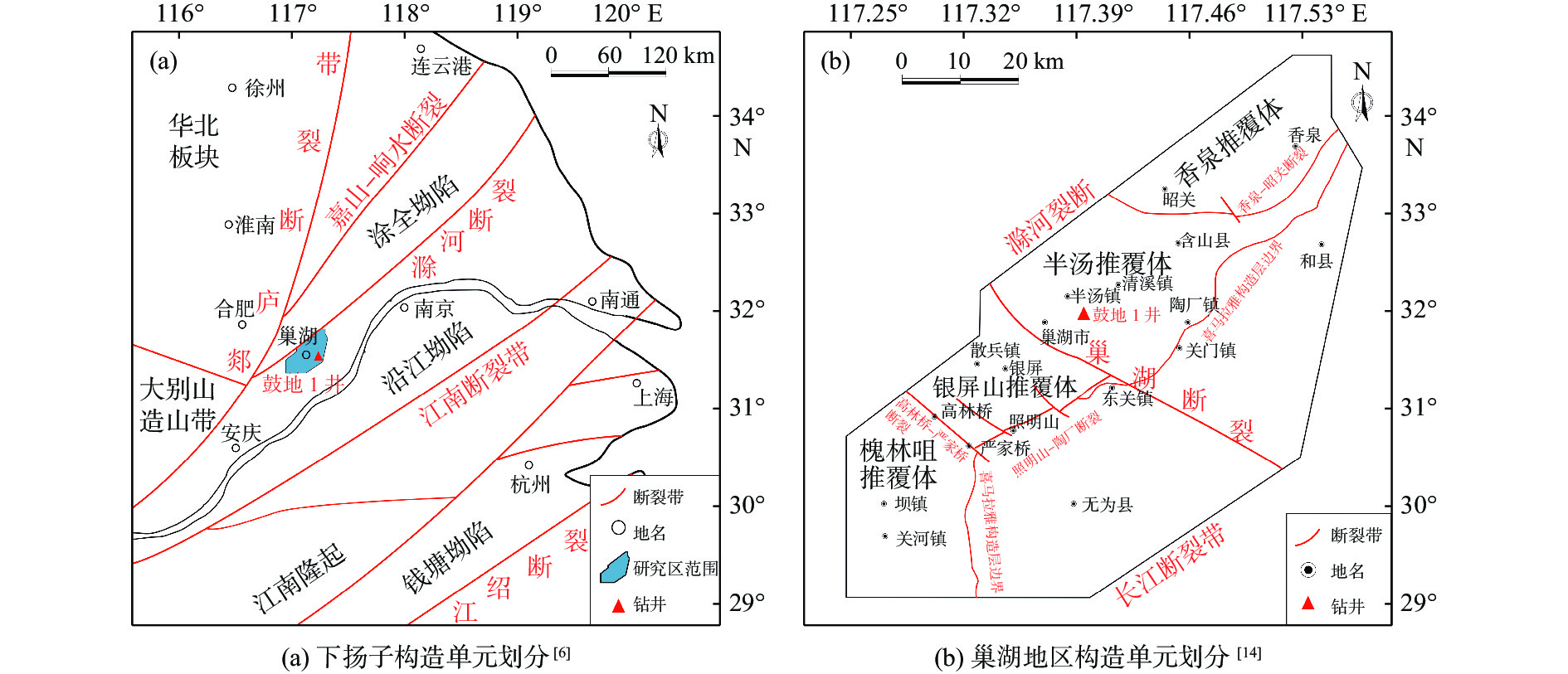
 下载:
下载:
